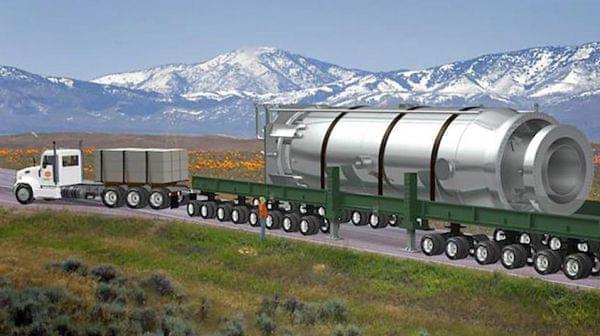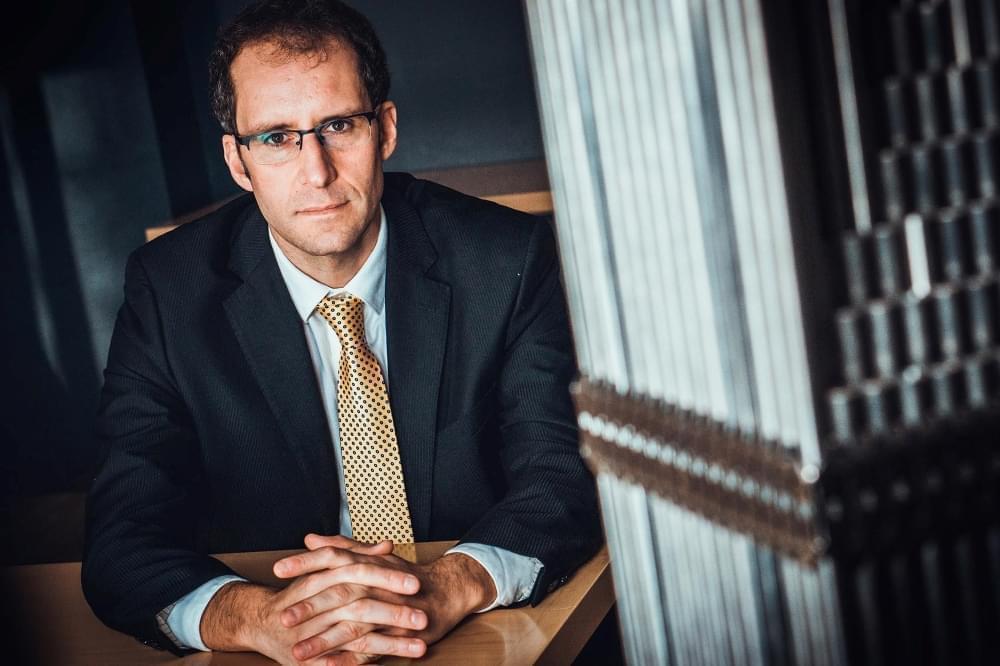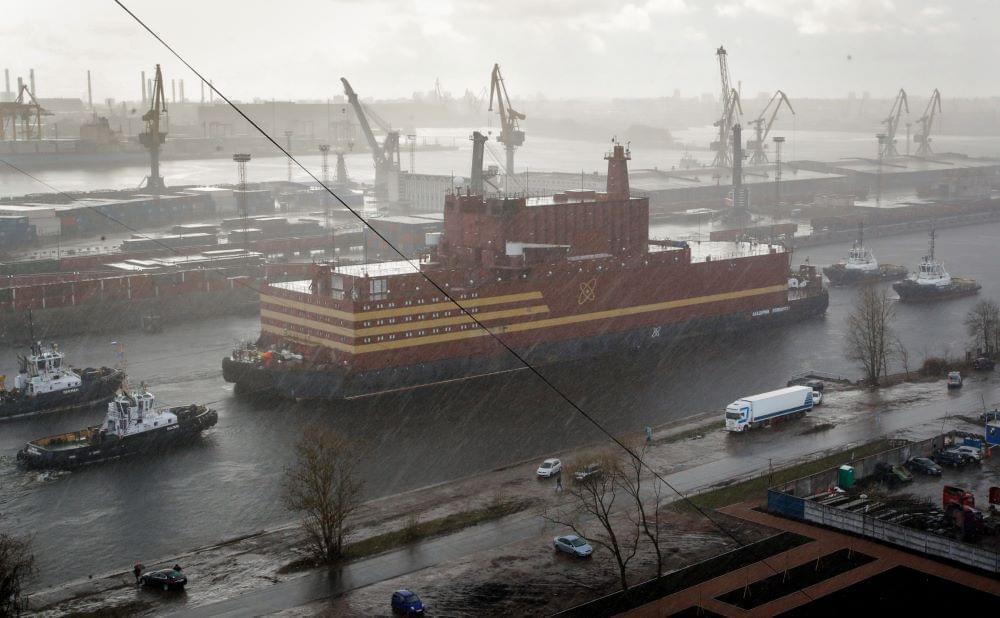Big Plans For Small Nuclear Plants

An artist's rendition of a miniature nuclear reactor in transit. Courtesy NuScale Power
The future of nuclear power has long been part of the history of the Massachusetts Institute of Technology. MIT's Nuclear Reactor Laboratory, built in the 1950s, is the second-largest university reactor in the United States. But it's small — operating at just 1% of the energy of the recently closed Pilgrim Nuclear Power Station.
MIT's reactor doesn't produce power; it's a training and research tool. And working with it is the "best job in the world," according to Jacopo Buongiorno. "We have fun with new nuclear reactor concepts."
Buongiorno is co-leader of the Reactor Lab and head of MIT's Center for Advanced Nuclear Energy Systems, where what's old is new, and "small" is the cutting edge of nuclear's future. Buongiorno investigates how advanced nuclear plant designs and construction techniques can be used to power our warming planet as fossil fuels are phased out.
"For nuclear, historically we always start with, 'What about the waste? What about the safety? What about proliferation?' And those are important issues we have to address," says Buongiorno. "But first, let's see why you'd want to mess with this technology to begin with."
Here's why: Just 97 U.S. nuclear power plants produce 20% of the nation's electricity — and more than half of our low-carbon power. Most were built over 40 years ago and many are scheduled for shutdown. Only one new reactor has been licensed in a quarter century.
"That has to change because we have a have a big problem, which is climate change," says Buongiorno. "And nuclear can be a big, big part of the solution."

Jacopo Buongiorno, MIT Nuclear Reactor Laboratory director of science and technology.
But the big, complex nuclear plants of the past are part of the problem, because they're enormously expensive to build and maintain. The cost of two large reactors currently under construction in Georgia has doubled to $28 billion, and they're years behind schedule.
So now Buongiorno and other nuclear engineers, scientists and startups are thinking small, with simple, faster and cheaper nuclear reactor designs.
"It's one thing to embark on a project that can cost a billion dollars; another that [sic] costs $10 billion," says Buongiorno. "A $10 billion project you're betting the farm, a billion dollars — even if it goes catastrophically wrong — you don't break the bank."
But can the world bank on nuclear power to help address climate change, given concerns over cost, safety, proliferation and radioactive waste?
"Those problems are solvable in principle," says former Obama science adviser John Holdren, who is now a professor of environmental policy at the Harvard Kennedy School. "But I'm agnostic on whether we will be wise enough able to solve them in practice."
Not everyone is agnostic. Earlier this year, nuclear power's true believers and renewable energy advocates met at an MIT conference to discuss the future of energy.
There, Chris Colbert, chief strategy officer at NuScale Power, pitched the Oregon company's design for a small modular nuclear reactor.
"What we've done is go to a smaller design — we've got no reactor coolant pumps. And the consequence of that decision is we've been able to eliminate two-thirds of the systems and components you find in a large plant," says Colbert.
At 76 feet high and 15 feet in diameter, a self-contained NuScale reactor would take up just 1% of the space of a conventional reactor. Buried deep in the earth and surrounded by millions of gallons of water, one reactor could power a remote region. Twelve modular reactors, stacked up like beer cans in six packs, could serve a city.
"The minute you get rid of two-thirds of the stuff, there's less stuff to buy and install, less stuff to operate and maintain, less stuff to break and go wrong," says Colbert. "It becomes safer, more cost-effective, easier to build."
To save on construction costs, NuScale plans to use a standardized design, mass producing modules in factories, transporting them to sites, and installing them in the ground. Colbert says they'll also be cheaper to operate.
NuScale plans to begin commercial production in six years. It's one of about a dozen companies trying to enter the emerging small modular market. The firm's first test reactor will be built at the Department of Energy's Idaho National Laboratory. It's part of Energy Secretary Rick Perry's plan to jump-start the nation's aging nuclear industry.
"We're going to make nuclear cool again," says Perry. "For 30 years we've let nuclear sit there and atrophy."
Cool comes at a cost. The DOE has invested $300 million in NuScale's small modular reactor design. But there's foreign competition in the market, and the United States is playing catch-up.
"We see this as a competition with Russian and Chinese state-owned enterprises who don't have the same commitment to safe operation that the United States does," says Colbert.
The Russian state atomic energy corporation Rosatom recently delivered a floating nuclear power plant with two small reactors to eastern Siberia. Russian officials say it will be full operational by the end of December.

Floating nuclear power plant Akademik Lomonosov is towed out of the St. Petersburg, Russia, shipyard where it was constructed.
Greenpeace calls the project "Chernobyl on Ice," warning of collisions with other vessels, terrorist attacks and storms. The Russian nuclear agency calls the concerns "unfounded" and says the floating reactors offer "clean, green, stable energy."
China has also announced plans to launch a fleet of up to 20 floating nuclear power plants. Construction of the first is set to begin soon.
A small team at MIT has been studying the feasibility of a similar idea. Buongiorno says the plan calls for building small reactors in shipyards then towing the nuclear platforms offshore where needed.
"It becomes a 'plug and play' energy source," says Buongiorno. "You build it, you float it out to the site and provide electricity. But if there is a more profitable site you simply move your power plant there."
The United States military did something like this 50 years ago, anchoring a reactor aboard a barge on a lake in Panama to power canal locks during a decade-long drought.
Now, as the climate rapidly changes, proponents of nuclear power say it's time to get back to the future. But former Nuclear Regulatory Commission Chairman Gregory Jaczko is dubious, saying that more mini-reactors on sea and land will mean more nuclear accidents.
"Every day almost you see a new story, talking about how we’re not going to solve the problem of climate change without nuclear reactors," says Jaczko. "And when I see those things I scratch my head and wonder if they’re talking about the same industry I’ve been familiar with, because I don’t see how nuclear power plants are going to solve that problem."
"I think we need all the options on the table, and that includes nuclear," says Ashley Finan, executive director of the Nuclear Innovation Alliance. She's an expert in funding new, advanced reactor designs, and says that economics are the key to the future success of nuclear power.
"If it's not competitive it won't scale and it won't address climate," Finan says.
But the scale will have to be enormous. Right now there are 448 nuclear reactors operating worldwide. Meeting emission targets — and the increased demand for electricity — could require building hundreds, if not thousands, of new nuclear reactors over the next three decades.
Climate change is here. Time is not on our side. The choices don't get easier.
This story is Part 2 in a series on the future of nuclear power. Part 1 is here. Part 3 is here.

This story originally appeared on NPR and WBUR's Here and Now. It is republished here as part of Illinois Newsroom's partnership with Covering Climate Now, a global collaboration of more than 250 news outlets to strengthen coverage of the climate story.
Links
- To Combat Climate Change, Do We Need The Nuclear Option?
- Student Activists Prepare For Climate Strike; Police And Home Surveillance Cameras; Fall TV Preview
- TV Weathercasters Who Are Shifting Public Opinion On The Climate Crisis
- How Reporters From Across The U.S. Cover The Climate Emergency
- A New Beginning For Climate Reporting
- ‘Americans Are Waking Up’: Two Thirds Say Climate Crisis Must Be Addressed
